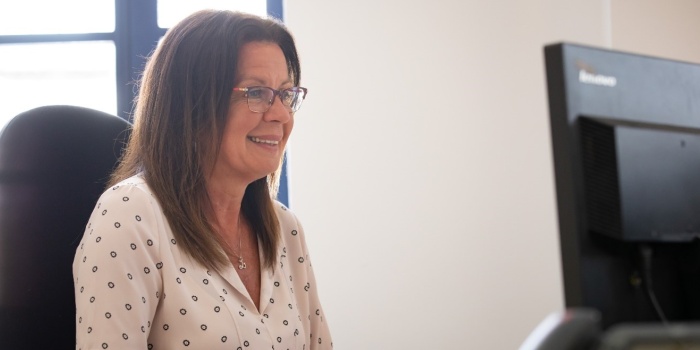The latest facial recognition technology: 3 reasons it might improve underwriting and benefit client wellness

Since the invention of the computer and the advent of the internet, technology has rapidly progressed, filtering into our everyday lives and changing the way our society functions on a daily basis.
The pandemic forced difficult restrictions on many households and made certain technologies even more necessary and essential, such as cloud technology, team management apps, and video call systems.
It was inevitable that technology would start to have a greater influence on the healthcare and protection industries. One possible way it might help the sector is through improving the underwriting process.
It is an area that Darren Lee, the head of underwriting and claims at John Lamb Hill Oldridge, recently wrote about for COVER magazine.
Read on to discover how facial recognition software works and why Darren believes it could change underwriting for the better and benefit client wellness.
Facial recognition is a method of analysing and understanding patterns that teaches machines to recognise human faces
In the early 1960s, work began on trying to create software that would allow machines to overcome the challenge of being able to recognise and distinguish between different human faces.
The concept was developed over the next few decades until it is now commonplace among the general public. It has become a vital security measure in the age of technology, helping people to protect and restrict access to their smartphones, tablets, and even online banking.
Facial recognition AI software captures, analyses, and maps out the various attributes of the human face and cross-references it against future images to determine if they are the same individual.
Biometrics, the school of science that facial recognition falls under, is still developing and is likely to continue to make leaps forward in the coming years.
Underwriting is an area where facial recognition might provide rapid new developments in the near future. It’s a welcome boost to a sector that hasn’t seen much fundamental change in the last few centuries.
As Darren puts it: “If you took a brief glance at a life insurance application from 1850, it would be enough to prove that the underwriting process has remained largely unchanged for nearly 200 years”.
Current underwriting processes can be onerous and time-consuming
A client applying for life insurance currently, whether directly through a broker or online, is required to answer a lengthy list of questions in considerable detail.
Underwriters need in-depth knowledge of a client’s:
- Health
- Occupation
- Travel habits
- Potentially dangerous hobbies.
Additionally, they will need to know a client’s age and the amount of cover required.
In some cases, the answers given necessitate a medical. This could include:
- An ECG
- Blood pressure checks
- Blood and urine samples
- The need to request GP notes.
All of these steps could cost a client valuable time, effort and money.
An automated initial underwriting process that utilises facial recognition software could evaluate a client virtually using a simple camera and might potentially streamline the journey.
3 powerful reasons facial recognition might improve the underwriting process
- The rapid development of technologies in the pandemic could allow remote evaluations
Darren posits: “The importance and prevalence of remote health-monitoring technologies has grown in our post-Covid world, a trend that will likely continue.
“Improvements in facial-recognition software, artificial intelligence and the complexity of mathematical algorithms could soon be used to accelerate the underwriting process”.
One way this might take effect is through remote photoplethysmography. It detects variations in skin colour and uses the information to identify potential health issues. This could be used to spot the “micro signs” of risks that are crucial to underwriting a life insurance policy.
Another way facial recognition technology might examine a client is through analysing a photo taken through an app designed to calculate facial blood flow. This could provide sufficient data to predict or measure a client’s:
- Heart rate
- Stress intensity
- Cholesterol levels
- Blood sugar levels.
- Facial-recognition technology could speed up the process and save clients’ money
The process of medicals and questionaries could be streamlined by technology and be performed fully remotely.
In the future, a smartphone with facial recognition software enabled could be sufficient enough to perform a remote medical, speeding up the underwriting process and vastly improving the client journey.
This could improve clients’ experience and related costs by:
- Eliminating the need for intrusive exams
- Reducing the need for nurse screenings
- Allowing clients with vulnerable conditions to stay at home
- Reducing the steps involved and the associated costs.
The development of this technology will rely on its ability to be accurate and reliable. Darren notes that: “while numerous studies are currently underway, it is early days, and it is too soon to accurately predict the technology’s real-world applications. The system’s accuracy in determining potential health risks will be key”.
- The ground-breaking technology has huge implications for client wellness
Historically, underwriting hasn’t focused on building ongoing relationships. Typically, once a medical exam has been completed and a report filed, the medical professional’s involvement ends.
Additionally, once the policy itself is in place this can be true of the insurer too.
A shift towards more ongoing support and continued monitoring could make a huge difference to client wellness. Any boost to a clients’ health and emotional wellbeing is a win.
It could reduce claims and provide clients with valuable reassurance that their ongoing health remains under observation.
Continuous monitoring and checks could involve:
- Daily step counts
- Help with diet and nutrition
- Annual blood screens
- Annual health checks.
If a client engages with these initiatives, it could lead to discounted premiums.
In the future, a regular health check might take place through facial recognition software and could be a simple and quick process. Any risks identified could trigger a GP referral or automatically prompt further medical testing.
If you’d like to read further insights from Darren, you can find his unabridged article in COVER magazine.
Get in touch
As Darren states in his article: “New technologies herald exciting times for the industry. Clients applying for life insurance in the future will find the process unrecognisable from the one in place today, let alone 200 years ago”.
Underwriting is a crucial step in the protection process. Staying ahead of developments and advancements in the industry is at the heart of our offering at John Lamb Hill Oldridge.
If you or your clients are interested in reviewing protection options and best next steps, the first step is getting in touch by email at [email protected] or by calling us on 020 7633 2222.
Please note
Note that life insurance plans typically have no cash in value at any time and cover will cease at the end of the term. If premiums stop, then cover will lapse.
This article is no substitute for financial advice and should not be treated as such. To determine the best course of action for your individual circumstances, please contact us.
Other Insights
John Lamb Hill Oldridge launches dedicated insurance-based investment products advice team
In recent months, many high-net-worth (HNW) individuals and families will have found themselves affected by changes to the Capital Gains Tax (CGT) rules and proposed reforms of the “non-dom” regime. To help advisers and their [...]
Holly Hill promoted to associate director
The UK’s foremost specialist protection adviser, John Lamb Hill Oldridge, has boosted its leadership team by promoting Holly Hill to the role of associate director. A former Team GB rower, Holly joined John Lamb Hill [...]
John Lamb Hill Oldridge wins gold at the Citywealth Magic Circle awards
Here at John Lamb Hill Oldridge, we are dedicated to providing the highest quality service to all of our clients. It is our mission to help them feel reassured about the future by arranging the [...]



